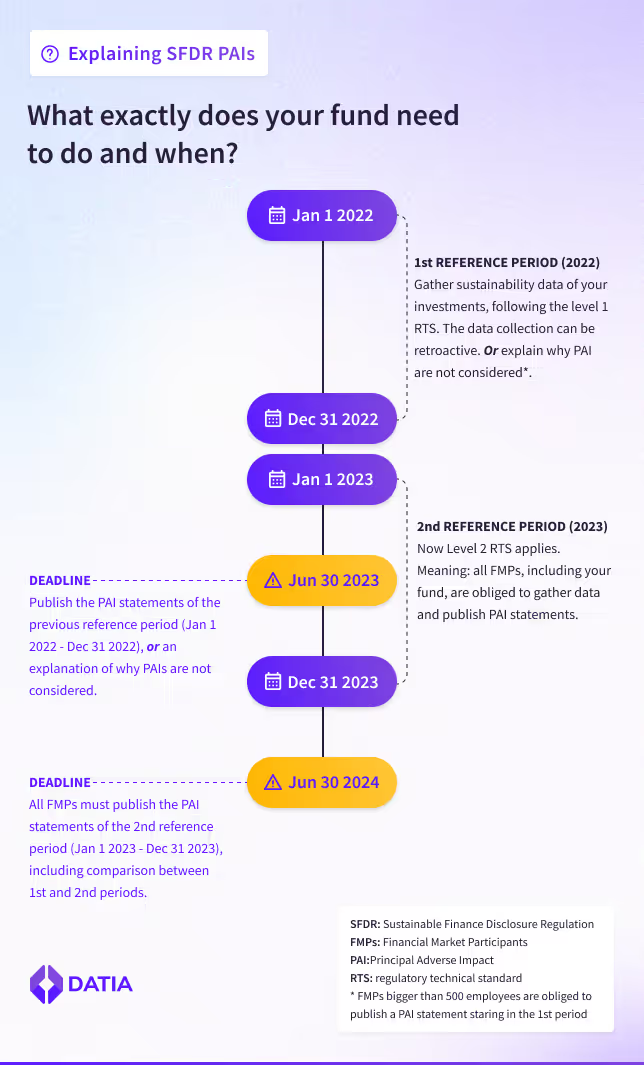Key takeaways
- What is a PAI statement
- Who needs to publish a PAI statement and when
- How to build a PAI statement or how to have it built by Datia
(This article was updated on September 27th, 2023)
What is a PAI statement
PAI stands for Principal Adverse Impacts and, as the name suggests, it is a list of activities or consequences of business activities that negatively impact the environment or society. For example, "hazardous waste and radioactive waste ratio"; "rate of accidents"; "lack of anti-corruption and anti-bribery policies", etc.
According to the Sustainable Finance Disclosure Regulation (SFDR), Financial Market Participants (FMPs) need to, progressively, report metrics related to the Principal Adverse Impacts but also need to publicly state actions taken or planned to improve these metrics. Note that we wrote “progressively”. That’s because, in the first deadline, June 30th, 2023 (see timeline below), smaller FMPs can be exempted from producing this statement, as long as they publicly give an explanation for their decision to not produce it.
Who needs to publish a PAI statement and when
There is one main deadline you have to add to your calendar every year, starting in 2023: June 30th.
By June 30th, 2023, all FMPs with more than 500 employees needed to publish their PAI statements publically. If you work for an FMP with less than 500 employees, this first PAI statement was optional. Therefore, by June 30th, 2023, your institution needed to choose: publish either your PAI statement publically or an explanation of why PAIs are not considered.
The second deadline is June 30th, 2024. FMPs must publish their second PAI statement publically. This time around, the PAI statement needs to add a comparison between the two reference periods: January to December 2022 and January to December 2023.
From 2024 on, the PAI statements always have to include comparisons between time periods.
Here’s a simplified timeline. Feel free to save it and share it with your team!

How to build a PAI statement or how to have it built by Datia
The first step is to understand all PAIs and which of those are mandatory and which are additional. In total, 64 adverse impact indicators, of which 18 are mandatory, and 46 are additional. Your FMP needs to report on the 18 mandatories, of course, and then choose at least one additional “environmental” indicator and at least one additional “social” indicator.
The second step is to collect data about each of the PAIs of each of the companies in your portfolio. The third step is to calculate the portfolio-level PAIs, using formulas provided in Annex I of the EU Regulation (EU) 2019/2088.
Finally, your fund or entity needs to publish publicly, for example, on its website, the final PAI statement.
For funds and asset managers using Datia for their sustainability reports, this process is much easier. Here’s what it looks like:
1) You upload your portfolio(s) to Datia’s platform quarterly
2) Datia ensures all the sustainability data needed is collected across multiple asset classes, including stocks, bonds, mutual funds, and more.
3) The PAI statement is automatically generated, and calculation methodologies are explained in the dashboard. Here’s an example:

4) You can export your PAI statement with one click. 5 languages are available today: English, Swedish, Norwegian, Danish, and Finnish.
Here’s a sample page of a PAI statement created on Datia:

How Datia can help
Datia enables FMPs of any size to publish a PAI statement.
- PAI indicators from +36,000 companies, +210,000 public funds, and +210 sovereign nations (or use your own data)
- Transparent and traceable data (origin, reporting periods, and links to original documents)
- Automatic calculations based on your portfolio snapshots
- PAI statement ready to download in pdf or editable format, and in multiple languages
- PAI indicators automatically inserted into funds’ EET files
Learn more about Datia's solution for PAI statements.


